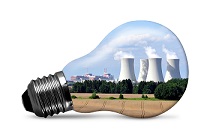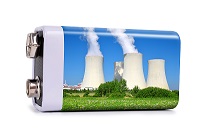Because We're Stronger Together – Nuclear Energy in India
“I would like nuclear fusion to become a practical power source. It would provide an inexhaustible supply of energy, without pollution or global warming.” -Stephen Hawking
 As an author of the article, I weigh the strength of Nuclear energy against the Country’s title as a Developing Country! India has been long in the status of developing the country for ages now. It has all the potential to be termed as a Super Nation, yet some strands are pulled back as the growing challenges do not equate the supply and the deficit. The lack of basic livelihood and energy infrastructure down weighs the economic development. Energy is a crucial element for economic development, the growth of economic development reflects the demand for better-quality energy services. Developed nations have built up virtuous circles of improvement in energy framework and commercial development. Whereas, the procedure has scarcely got off the ground for many impoverished countries.
As an author of the article, I weigh the strength of Nuclear energy against the Country’s title as a Developing Country! India has been long in the status of developing the country for ages now. It has all the potential to be termed as a Super Nation, yet some strands are pulled back as the growing challenges do not equate the supply and the deficit. The lack of basic livelihood and energy infrastructure down weighs the economic development. Energy is a crucial element for economic development, the growth of economic development reflects the demand for better-quality energy services. Developed nations have built up virtuous circles of improvement in energy framework and commercial development. Whereas, the procedure has scarcely got off the ground for many impoverished countries.
Power sector satisfies the most essential and fundamental human needs: food and housing. It additionally adds to social development by enhancing education and public health. Amid the early phases of development, the supreme measure of energy utilized per capita and the share of current energy services – particularly power – are key contributors of human advancement.
“Nuclear power is one hell of a way to boil water”
-Albert Einstein.
The Scientific Bit
Nuclear plants are a similar platform as coal and hydro plants that consume coal, oil and flammable gas, and deliver power by bubbling water into steam. This steam then swings turbines to produce power. The distinction is that nuclear plants don't consume anything. Rather, they utilize uranium fuel, comprising of durable ceramic pellets, to create power through a procedure called fission.
Nuclear power plants obtain the required temperature to facilitate steam running through a physical process. This process termed as fission involves the splitting of atoms of uranium in the core of a Nuclear reactor. The uranium fuel comprises of small, hard ceramic pellets that are fed to vertical tubes. A sizeable quantity of this fuel is embedded into the reactor.
A Feather in the Hat:
 India has a flourishing indigenous nuclear power and hopes to have 14.6 GWe nuclear limit online by 2024 and 63 GWe by the year 2032. It means to supply 25% of power from nuclear energy by 2050. Because of prior exchange bans and absence of indigenous uranium, India has especially been building up a nuclear fuel cycle to endeavor its reserves of thorium. India has a dream of turning into a world pioneer in Nuclear innovation because of its mastery in fast reactors and thorium fuel cycle.
India has a flourishing indigenous nuclear power and hopes to have 14.6 GWe nuclear limit online by 2024 and 63 GWe by the year 2032. It means to supply 25% of power from nuclear energy by 2050. Because of prior exchange bans and absence of indigenous uranium, India has especially been building up a nuclear fuel cycle to endeavor its reserves of thorium. India has a dream of turning into a world pioneer in Nuclear innovation because of its mastery in fast reactors and thorium fuel cycle.
The Atomic Energy (Amendment) Act, 2015 – Key Highlights:
- The Nuclear Power Corporation of India Limited (NPCIL) is in charge of design, development, dispatching and operation of thermal Nuclear power plants. The Nuclear Energy (Amendment) Act, 2015 came into force to enable the NPCIL to enter joint ventures with other Public Sector Undertakings(PSUs).
- The amendment has been brought to facilitate the quick extension of Nuclear power, utility and foundation and the utilizing of nuclear energy for peaceful purposes. Under the Act, a "Government Company" is one in which the Central Government holds no less than 51 (fifty-one) percent of the paid-up share capital.
- The 1962 Nuclear Energy Act disallows private control of Nuclear power generation, and the 2016 changes permitting public sector joint ventures do not extend to private sector companies, nor allow direct foreign investment in nuclear energy, aside from the supply chain.
- The primary target of empowering the JVs is to accomplish the extension of nuclear power limit in the nation. Up until this point, three joint ventures organizations – Anushakti Vidhyut Nigam Limited, Indian Oil Nuclear Energy Corporation Limited and Nalco Power Company Limited have consolidated.
- India holds 21 working nuclear projects currently in the country, which produce an expected 5.8 GW of electricity of a sum of roughly 300 GW of installed capacity as of May 2016. This records for only 1.8 percent of total generating capacity. Five nuclear projects are targeted to finish in 2017, including a further 3.8 GW, taking the aggregate total installed capacity to 9.6 GW.
- Some view the latest proposal by NPCIL to collaborate with the money rich PSUs namely ONGC Ltd and the Indian Railways as an alternate strategy to overcome the lack of monetary funds and increase viability for new projects using the indigenous pressurized heavy water reactor technology.
- Apart from natural energy, talks are underway to export nuclear reactors from overseas sources. In March 2010 a proposal for building six more reactors at Kudankulam by 2017 and four more at Haripur after 2017 was planned, taking the aggregate to 12. The number will probably expand after 2017, according to India's 13th five-year plan. Russian organization Atomenergomash (AEM) has set up an office in India in this regards to access the future needs.
- Other significant foreign collaborations are, Areva entering into an MOU with NPCIL in February 2009 to build up to four Reactors. Hitachi Nuclear Energy, Westinghouse, Atomic Energy of Canada and Korean Power Company (KEPCO) are other developments where NPCIL entered into Memorandum of Understanding to boost India’s Nuclear Energy sector.
- The Indian government ratified the Convention on Supplementary Compensation for Nuclear Damage (CSC) with the International Atomic Energy Agency on 4th of February, 2016. This is a positive move towards importing international nuclear services vendors. Earlier, Indian law held the providers of nuclear plants conceivably at risk in case of a mishap, in contrast to the international norm in which the liability falls to the power plant operator.
- A view of the operating Nuclear reactors in India:
| Power Station | State | Units | Total Capacity (MW) |
|---|---|---|---|
| Tarapur | Maharashtra | 160 x 2 and 540 x 2 | 1,400 |
| Rawatbhata | Rajasthan | 100 x 1, 200 x 1, and 220 x 4 | 1,180 |
| Kundankulam | Tamil Nadu | 1000 x 2 | 2,000 |
| Kaiga | Karnataka | 220 x 4 | 800 |
| Kakrapur | Gujarat | 220 x 2 | 440 |
| Kalpakkam | Tamil Nadu | 220 x 2 | 440 |
| Narora | Uttar Pradesh | 220 x 2 | 440 |
A Total of 6,780 MW; are all run by NPCIL.
Conclusion
Nuclear energy is a valuable source of power generation and is in constant debate for its success and safety. The Fukushima Daiichi nuclear disaster in 2011, Chernobyl disaster of 1986, Three Mile Island accident dated 1979, and the SL-1 accident of 1961 warns us about the possible consequences. One wrong button would lead to chaos and annihilation of human survival on Planet Earth! It could result in Natural Catastrophes, Act of War, Terrorism or Super Science. It may be time to decode the recent statement made by Stephen Hawking that “Humans have 100 years left on Earth”!
 English
English
 عربي
عربي Русский
Русский 官话
官话 português
português
 Türk
Türk 











